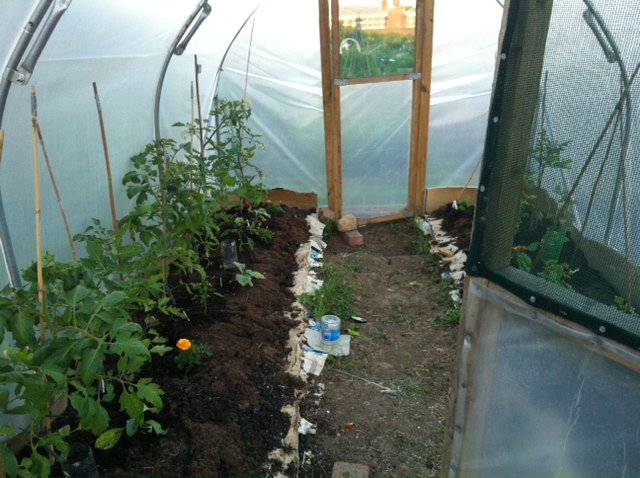
I sowed the plants for the polytunnel before we started building the polytunnel. First things first, I started all those tender, warmth loving things by my feet in my office, cosied away in a heated propagator, and later moved them up onto the office windowsill and later still out into the greenhouse. There they patiently awaited the day when they could be planted out. While the polytunnel was still a jumble of metal poles and a page of scribbled instructions, my tomatoes, chillies, sweet peppers, cucumbers, melons and more were snaking their way out of their pots, confidently growing away as if there might actually be a home for them someday, somewhere…
Although this early sowing did start to feel a little foolish as the plants were nearly toppling over in their little pots in the greenhouse, it did provide a certain impetus. It really would have been too bad to start with such optimistic intentions in January and have to abandon them come June, so the 57 (or so) separate tasks that had to be completed before I could actually start planting up were, finally, completed. This thing is done. The plants are in.
Having foolishly positioned my greenhouse below a particularly healthy and leafy tree at the end of the garden it has been some years since I have seen tomatoes growing happily. If I tried growing them outside they got blight, if I tried growing them inside they looked drawn up and unhappy, Mediterranean plants forced to live in a northern European climate, and under a tree to boot. But the amount of light and heat in the polytunnel is awesome. The polytunnel is next to the path at the top of a south-west sloping hill. There is nothing to shade it, not a single stem, and certainly not a big cherry tree. The plants just look about as happy as can be, fat, stout, green, flowering and with the start of little fruits.
I’m particularly delighted because their soil is not what it might be. The polytunnel build was slow partly because we decided to do it over a very unloved stretch of allotment. It has been unused and colonised by couch grass and bindweed for a very long time, and the clay soil had not seen an ounce of organic matter for years. When our soil hasn’t had lovely things added to it, it seizes up, and it would have taken months of painstaking work to pull every last couch grass root out of it. Instead we covered it first with manure, then with layers of wet newspaper and cardboard, then more manure and finally a few bags of compost. We planted straight into that and hoped for the best. The idea is that the lack of light slowly kills the weeds beneath, but that while this is happening the soil is being softened and improved by the slow and steady incorporation of the manure in the soil not by digging, but by worm. It’s a lazy way but a good way, and the plants look so happy, even though their roots can only be in a few inches of soil. The weeds do keep poking through – the bindweed in particular – but they are easy to tug out of the soft compost.
I’m delighted to have got it all up and running and I’m sure it will become a favourite place to be once the weather cools down. At the moment I don’t want to be in it for more than about 2 minutes at a time, the heat is so fierce, but the tomatoes love it, and that’s what counts.


